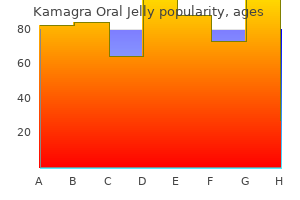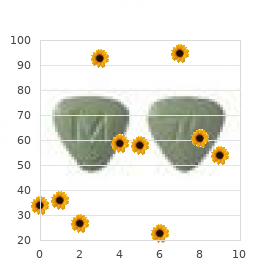


Kamagra Oral Jelly
"Order kamagra oral jelly 100 mg free shipping, impotence or ed".
X. Myxir, M.A.S., M.D.
Vice Chair, Howard University College of Medicine
Recording Methodology the tiny magnetic fields generated by the neuronal currents induce an electrical present within the detection coils that are rendered superconducting by immersion in liquid helium erectile dysfunction doctor in columbus ohio 100 mg kamagra oral jelly sale. Patients may be recorded in the supine or sitting position causes of erectile dysfunction in 60s 100 mg kamagra oral jelly overnight delivery, both at relaxation or present process testing with sensory or cognitive stimuli erectile dysfunction water pump 100 mg kamagra oral jelly purchase with amex. The places of the position-indicating coils on the pinnacle are, in flip, established before the patient enters the shielded room, normally with a wand-like system (that in most methods also makes use of magnetic field localization principles). These two procedures have become routine, and scientific apply guidelines have lately been printed. Demonstration of widespread or multifocal discharges suggesting an unfavorable prognosis for epilepsy surgical procedure. Guidance for implantation of intracranial electrodes when invasive analysis turns into needed. Identification of eloquent areas of the cortex and their proximity to deliberate areas of resection. Locating the areas of the mind answerable for regular perform is an important 988 Magnetoencephalography part of the planning course of in patients being considered for resection of mass lesions or vascular malformations. By localizing exercise throughout outlined sensory tasks, presurgical mapping of eloquent areas of the mind guides the surgeon operating in an adjoining region. Baumgartner C, Pataraia E, Lindinger G, and Deecke L (2000a) Neuromagnetic recordings in temporal lobe epilepsy. Baumgartner C, Pataraia E, Lindinger G, and Deeke L (2000b) Magnetoencephalography in focal epilepsy. Cohen D (1968) Magnetoencephalography: Evidence of magnetic fields produced by alpha rhythm currents. Four species within the protozoan coccidian genus Plasmodium trigger malaria, a disease sometimes marked by episodic fevers and chills. The definitive hosts, mosquitoes of the genus Anopheles, transmit the an infection among folks. The rupture of schizont-infected purple blood cells marks the onset of clinical malaria. The parasite amplifies its numbers and provokes disease by way of cycles of schizogony and reinvasion of red blood cells. Spiking fever, episodic chills, headache, nausea, vomiting, and muscle ache usually occur with acute malaria in individuals who lack the naturally acquired immunity to illness that comes with chronic exposure to infection. Endemic malaria occurs throughout most of the tropical latitudes, but seasonal transmission could occur wherever between the polar circles where infectious human beings combine with domestically plentiful and receptive anopheline mosquito populations. Diagnosis Diagnosis in endemic areas, the place malaria causes most febrile disease, is usually made primarily based on the presentation of this scientific spectrum. Symptoms of uncomplicated malaria vary from none (as in most semiimmune adults in holoendemic areas) to debilitating These patients almost always totally get well with appropriate outpatient management. Each invading sporozoite turns into a schizont that matures to yield as a lot as 40 000 merozoites over a period of one to several weeks (long-term latent forms of P. Some merozoites as an alternative develop to sexual varieties referred to as gametocytes (distinctive female and male types appear separately) that fuse and undergo meiosis within the gut of anopheline mosquitoes to produce sporozoites in the salivary glands. Demonstration of plasmodia within the blood of sufferers with central nervous system dysfunction who lack proof of other contributing causes constitutes the premise of the prognosis of cerebral malaria. Cerebral malaria represents the best menace to vacationers and young youngsters living the place moderate transmission happens. Severe anemia is the higher risk to infants and younger kids the place malaria is holoendemic. The precise case definition of cerebral malaria is a syndrome characterized by signs of cerebral dysfunction unexplained by hyperpyrexia or detectable metabolic abnormalities. In follow, nevertheless, severe disease could manifest with each cerebral and systemic symptoms. Severe and complicated malaria consists of those infections marked by hyperparasitemia (4100 000 parasites per ml of blood), cerebral involvement, severe anemia, hypoglycemia or proof of organ dysfunction, renal failure, lactic acidosis, Gram-negative sepsis, and hemorrhage (Table 1). In most medical or epidemiological studies, cerebral malaria carries a poor prognosis, with roughly one in 5 sufferers admitted to hospital with a analysis of cerebral malaria dying, whatever the level of care out there. Unfortunately, the overall lack of particular efficient interventions beyond intravenous quinine remedy remains a serious impediment to care. The pathogenesis of cerebral malaria in all probability lies in the process of sequestration of late blood stage types within the vasculature of deep organs, together with capillary beds within the mind. Plasmodium falciparum expresses proteins on the floor of contaminated purple blood cells that bind to thrombospondin receptors on the surface of endothelial cells. Risk of cerebral malaria and a fatal outcome has been correlated to parameters reflecting a vigorous cellular immune response, especially cytokines similar to tumor necrosis issue, nitric oxide synthase, and interleukins-4, 6-, and -10. Pathological findings with cerebral malaria embrace ring hemorrhage, demyelinization, microglial accumulation, outstanding neutrophilic and lymphocytic infiltrates, and histiocytes laden with parasitized red blood cells and malaria pigment. Recovery from cerebral malaria may be full or carry everlasting neurological sequelae. The prognosis correlates instantly with length of unconsciousness, worsening as coma lengthens. Delayed or late neurological complications, designated the postmalaria neurological syndromes, additionally happen. These happen in sufferers who recuperate from cerebral malaria after which relapse 1 or 2 days later into coma. Inflammatory spinal fluids with elevated protein with or with no lymphocytic pleocytosis happen. Paradoxically, another necessary neurological side of malaria is the unwanted side effects related to quinine remedy. Quinine typically provokes a syndrome known as cinchonism which will include one or more of the next signs: ringing within the ears, excessive tone deafness, nausea, vomiting, headache, dizziness, amblyopia, photophobia, diplopia, diarrhea, urticarial rash, and dysphoria. Overdose may be related to everlasting harm to retinal and auditory ganglion cells and severe neurological problems, corresponding to blindness, deafness, seizures, and coma. Quinine also needs to be used cautiously in sufferers with myasthenia gravis because of its curare-like effect on motor end plates, lengthening the refractory interval of the skeletal muscle membrane. Most of those minor effects are transient and include headache, fatigue, insomnia, vivid dreams, short-term memory disturbance, blurred imaginative and prescient, dizziness, nice tremor, unsteady gait, depressed mood, and nervousness. Mefloquine can exacerbate underlying axis I psychiatric circumstances, similar to mood issues or psychoses, and reduce seizure threshold in people with underlying seizure problems, particularly those who are taking valproic acid. Apart from the plain medical components, therapeutic choices should be primarily based on the species concerned in addition to the geographic origin of the an infection and the corresponding risk of therapeutic failure because of drug resistance. These organizations additionally provide specific steering on the prevention of malaria in areas with drug-resistant parasites. Malformations of the brain and spinal twine may be genetically decided or they may be acquired. Most dysgeneses that occur early in gestation have a genetic foundation, whereas these beginning late in gestation extra doubtless result from harmful lesions corresponding to infarcts that may interfere with the development of particular constructions. Examples embrace ischemic lesions in the fetal mind related to congenital cytomegalovirus infections, fetal degenerative ailments similar to pontocerebellar hypoplasia and polymicrogyria in zones of relative ischemia that surround the porencephalic cysts resulting from a middle cerebral artery occlusion in fetal life. White matter infarcts in the cerebrum might destroy radial glial fibers and stop the conventional migration of neuroblasts and glioblasts from the subventricular zone or the germinal matrix. Regardless of trigger, malformations are historically categorised as disturbances in developmental processes. Although this type of classification retains its validity for understanding the type of developmental process most disturbed, similar to cellular proliferation or neuroblast migration, the current understanding of developmental genes and their position within the ontogenesis of the nervous system supplies a complementary molecular genetic classification of early neurogenesis that recognizes the genetic regulation of growth. An example of an try and use these new data to manage the pondering regarding the developmental malformations of the brain is proposed in Table 1, which supplies a scheme that may undoubtedly endure appreciable revision sooner or later as extra data turn into available. Developmental genes, corresponding to organizer genes in early ontogenesis and regulator genes at later intervals, could serve a collection of various features, thereby involving various processes. Just as no two adults, even monozygotic twins, are similar, no two fetuses and no two cerebral malformations are similar. Individual organic variations occur in irregular and regular improvement, and allowance have to be made for small differences while recognizing the principal patterns that denote pathogenesis. The welldescribed variants of holoprosencephaly (alobar, semilobar, lobar, and middle interhemispheric) are the degrees of severity and all are associated with numerous genetic mutations.
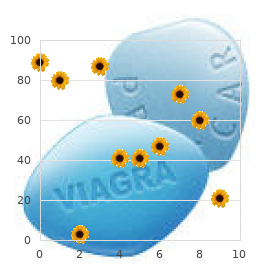
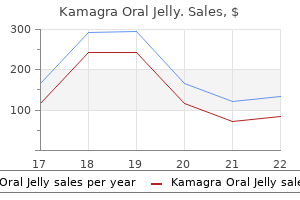
Sensitivity and specificity vary with every assay and the clinical presentation of the affected person erectile dysfunction doctor new jersey kamagra oral jelly 100 mg order free shipping. However erectile dysfunction doctors in tulsa buy 100 mg kamagra oral jelly mastercard, high titers could additionally be found in early-onset disease and in sufferers with thymoma erectile dysfunction early 20s kamagra oral jelly 100 mg purchase free shipping, and decreased titers following remedy correlate with symptomatic enchancment in some patients. In some sufferers, solely one of many obtainable assays (typically the binding antibody assay) is performed with a adverse outcome, whereas different assays may be optimistic. In different patients, high-affinity antibodies may aggressively adhere to their respective antigens in vivo, rendering standard assays unfavorable because of very low serum levels. Immunosuppression, particularly when administered for more than 1 year, might cut back antibody production to undetectable ranges. Seronegative patients appear to reply to immunosuppression, and growing evidence suggests vital heterogeneity amongst antibodies in these sufferers. Progressive will increase in titers will be the first indication of thymic tumor recurrence. The baseline decrement within every prepare may also transiently improve following exercise. A baseline train of repetitive nerve stimulation at relaxation demonstrates significant decrement by the fourth stimulus. A third train, 30 s after train, demonstrates worsening, with decrement exceeding baseline levels (due to postexercise exhaustion as acetylcholine vesicles are depleted). Analysis of jitter by numerous mathematical and computerized strategies permits quantitation of this phenomenon in any given patient and comparability of findings to normative values. These agents have their best utility in pure ocular illness, early delicate generalized disease, or as an adjunct in relatively stable but symptomatic illness following an applicable course of immunosuppressive remedy. Doses in excess of 120 mg each 3 h might produce paradoxical increases in weak point, resulting in cholinergic disaster. A slow-release type of this drug is sometimes used earlier than bedtime to decrease weak spot on awakening. It could additionally be notably useful in reducing early morning dysphagia in patients with weak spot of the pharyngeal muscular tissues, making it simpler for them to take their first morning dose of normal oral pyridostigmine. Intravenous acetylcholinesterase inhibitors, such as neostigmine, are also available for use within the hospital when the patient is not in a place to swallow the oral preparation. These agents had been main therapy for many years, before the application of the much more successful immunosuppressive measures discussed later on this entry. Two 1-ml tuberculin syringes ought to be ready: one as a placebo injection (1 ml regular saline) and one as an injection of 10 mg of edrophonium in 1 ml of resolution. The placebo is usually administered first, with observation for improvement for a few minutes. If no enchancment is famous, the remaining eight mg is given and the method is repeated. Any symptomatic improvement in responsive sufferers is brief lived, lasting not than 30 min. Several cholinergic side effects might seem following intravenous edrophonium, including asystole, bradycardia, syncope nausea, and excessive lacrimation and salivation, and the examiner should pay attention to these dangers, which in sure sufferers are relative contraindications for this check. All patients with thymic tumors, besides those with lots unfold extensively all through the mediastinum, should endure complete resection. Ideally, the myasthenia ought to be managed with applicable immunotherapy before the elective scheduling of this surgery. Although preoperative imaging research are crucial, antistriational antibody assays are also carried out in a high share of these sufferers. If the histopathology suggests malignancy, postoperative radio- and Myasthenia Gravis 227 chemotherapy are required and should significantly reduce tumor burden in some patients. Because the thymus performs an important role in the improvement of the pediatric immune system, thymectomy is often not really helpful in childhood, although the restricted out there knowledge recommend it could improve remission charges within the pediatric population. Patients older than 60 years are typically poorer candidates for any type of surgery, and since the thymus dramatically shrinks with age, its contribution to immune function is probably naturally decreased, making thymectomy theoretically less appealing in this group. Smaller numbers of older patients have undergone thymectomy, but some reports recommend therapeutic results much like those noticed in younger sufferers. Surgery in sufferers with pure ocular disease and no tumor is usually not beneficial. Immediate, however transient, enchancment in power lasting several days could also be famous postoperatively, with a decreased requirement for acetylcholinesterase inhibitor medication. The exact contributions of thymectomy to long-term enchancment and remission of the illness are troublesome to quantify as a end result of virtually all patients in the fashionable period are also treated with immunosuppressive medicine. Therefore, a decreased reservoir of antibody-producing tissue alone appears an unlikely rationalization for the observed results. Oral prednisone therapy grew to become extraordinarily in style after affirmation of the immunological reason for the disease in the early Nineteen Seventies and has remained a mainstay of remedy. Unfortunately, the apparently dramatic therapeutic effect of steroids and their sudden, widespread adoption precluded any giant placebo-controlled studies of their advantages and risks. However, most investigators agree that steroids are the most effective remedy for almost all of patients with this condition. There is common consensus that such therapy should begin with an intensive course, however differing induction regimens are beneficial by different authorities. Symptomatic recurrence could lag weeks to months after a dosage change and should require a return to larger doses of steroids before management is again achieved. However, because taper of steroids to lower dosage ranges may take 1 or 2 years, the risks of longterm unwanted aspect effects have to be thought of in each patient before initiation of therapy. This drug acts predominantly on proliferating B and T lymphocytes and reduces their numbers. These opposed effects are often reversible with discontinuation of the drug if found early. An idiosyncratic flu-like reaction may also occur with fever, myalgia, generalized malaise, and vomiting and should immediate instant discontinuation of therapy. It may have a task in decreasing perioperative morbidity as pretreatment for thymectomy and to buffer steroidinduced exacerbations. Mild nausea may happen and will reply to division of the dose into thirds and administration with meals. Potential teratogenesis and mutagenesis make pregnancy relatively contraindicated, and an elevated long-term threat of malignancy has been reported. Xanthine oxidase helps to metabolize this drug, and therefore concurrent administration of allopurinol may push levels dangerously excessive, rising the beforehand mentioned risks. Cyclosporin A Cyclosporin A decreases the manufacturing of interleukin-2 and interferon-g by helper T cells. It is amongst the few brokers subjected to , and proven efficient in, potential, double-blind, placebo-controlled trials. Onset of symptomatic enchancment usually begins within 2 weeks, with common maximal improvement at 3 or 4 months. Side effects embrace important acute nephrotoxicity (usually reversible with cessation of therapy), new-onset hypertension, delicate hepatotoxicity, a barely elevated risk of malignancy, hirsutism, and gingival hyperplasia. Side results are often mild and might include headache, chills, fever, and nausea. Pretreatment with acetaminophen and diphenhydramine may prevent these minor reactions. In current years, acute renal failure has additionally been acknowledged as a significant complication, occurring inside days of infusion. Cyclophosphamide Owing to its considerable unwanted effects, this drug is typically reserved for essentially the most severe and refractory cases unresponsive to different therapies. Nausea and vomiting, particularly distinguished with intravenous infusions, may require antiemetic remedy. In future many years, with the appearance of increasingly sophisticated immunomodulatory technologies, a universally efficient treatment for acquired myasthenia and other selective autoimmune disorders could also be achievable. Schonbeck S, Chrestel S, and Hohlfeld R (1990) Myasthenia gravis: Prototype of the antireceptor autoimmune ailments. However, the efficacy of thymectomy in these patients is difficult to gauge due to the small numbers of sufferers reported thus far.
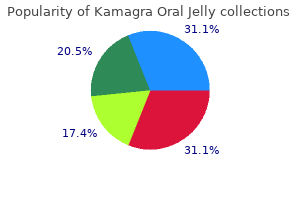
Severe irritation of bronchi and bronchioles ends in destruction of all components of the bronchial wall erectile dysfunction quotes kamagra oral jelly 100 mg order overnight delivery. Inflammation of central airways leads to erectile dysfunction causes emotional 100 mg kamagra oral jelly with amex mucus hypersecretion and abnormalities of the surface epithelium erectile dysfunction hormones kamagra oral jelly 100 mg cheap on line, including squamous metaplasia and increased goblet cells. Lymphoid follicles are often seen in bronchial partitions, and distal bronchi and bronchioles are scarred and infrequently obliterated. Bronchial arteries enlarge to supply the inflamed bronchial wall and fibrous tissue. A vicious circle may be established in which swimming pools of mucus turn out to be infected, which further promotes destruction of the bronchial partitions. Hemoptysis is common, as bronchial inflammation erodes the partitions of adjacent bronchial arteries. Pneumonia is common, and sufferers with longstanding cases are at threat of persistent hypoxia and pulmonary hypertension. Surgical resection of localized bronchiectasis may be needed, especially if issues similar to extreme hemoptysis or pneumonia arise. However, in the generalized illness, surgical resection is extra palliative than healing. Acute, reversible bronchial dilation might comply with bacterial or viral respiratory infections; it might take months earlier than the bronchi return to regular dimension. Bacterial pneumonias occur in three settings: Community-acquired pneumonia arises outside the hospital in people with no main dysfunction of the immune system. The major pulmonary entities are described below, with particular emphasis on pathologic features. Bacterial Pneumonia Is Inflammation and Consolidation of Lung Parenchyma Bacterial pneumonia was as quickly as divided into lobar pneumonia or bronchopneumonia, however these terms have little scientific relevance today. It typically develops in terminally sick patients, usually in dependent and posterior portions of the lung. Scattered irregular foci of pneumonia are centered on terminal bronchioles and respiratory bronchioles. At this stage, the congestion has diminished, but the lung is still agency ("gray hepatization"). A variety of issues might follow pneumococcal pneumonia: Nosocomial pneumonia is an infection that develops in hospital environments and tends to affect compromised sufferers. Bacterial pneumonias are greatest categorised by etiologic agent, as clinical and morphologic features, and thus therapies, often range with the causative organism. Most micro organism that cause pneumonia are normal inhabitants of the oropharynx and nasopharynx that reach alveoli by aspiration of secretions. Other routes of an infection include inhalation from the surroundings, hematogenous dissemination from an infectious focus elsewhere and (rarely) unfold of micro organism from an adjacent site. Emergence of a virulent organism within the oropharyngeal flora usually precedes the development of pneumonia. Predisposing conditions usually entail depressed host defenses related to cigarette smoking, chronic bronchitis, alcoholism, extreme malnutrition, wasting illnesses and poorly managed diabetes. Debilitated or immunosuppressed sufferers in the hospital usually have altered oropharyngeal flora, and as many as 25% could develop nosocomial pneumonia. It is rare in infants, much less common within the elderly and far more frequent in males than ladies. Pleuritis (inflammation of the pleura), usually painful, is common, because the pneumonia readily extends to the pleura. Empyema/pyothorax (pus within the pleural space) results from an infection of a pleural effusion and will heal with intensive fibrosis. Bacteremia occurs through the early levels of pneumococcal pneumonia in more than 25% of sufferers and may lead to endocarditis or meningitis. The intra-alveolar exudate organizes to form intra-alveolar plugs of granulation tissue, known as organizing pneumonia. Gradually, rising alveolar fibrosis leads to a shrunken and agency lobe, a uncommon complication generally known as carnification. Lung abscess (localized assortment of pus) is an uncommon complication of pneumococcal pneumonia. The thin, watery secretions carry the organisms into the alveoli, thus initiating an inflammatory response. Aspiration of pneumococci can also comply with impaired epiglottic reflexes, as occurs with publicity to cold, anesthesia and alcohol intoxication. Lung damage brought on, for example, by congestive heart failure or irritant gases additionally will increase susceptibility to pneumococcal pneumonia. The pneumococcal capsule protects the bacteria towards phagocytosis by alveolar macrophages. In an immune-competent individual, antipneumococcal antibodies act as opsonins, but a number not beforehand exposed to the specific infecting pressure of S. Radiologic studies present alveolar filling in giant areas of lung, producing a stable look that extends to complete lobes or segments. Before antibiotic remedy, severe fever, dyspnea, debility and even loss of consciousness had been widespread. Satisfactory decision of a disaster mirrored effective immune responses to the infection. Current therapy for pneumococcal pneumonia is effective, and though signs resolve rapidly, radiographic lesions nonetheless take a number of days to clear. Marked capillary congestion leads to huge outpouring of polymorphonuclear leukocytes and intra-alveolar hemorrhage. Because the colour and firm consistency of the affected lung are paying homage to the liver, this stage has been aptly named "red hepatization". Alveoli are packed with an exudate composed of polymorphonuclear leukocytes and occasional macrophages. The onset of Klebsiella pneumonia is less dramatic than that of pneumococcal pneumonia, however the disease may be extra dangerous. Staphylococcal Pneumonia Staphylococci account for only 1% of community-acquired bacterial pneumonias. Repeated episodes of staphylococcal pneumonia are seen in patients with cystic fibrosis, owing to colonization of bronchiectatic airways. Nosocomial staphylococcal pneumonia sometimes happens in chronically ill people who are susceptible to aspiration and in intubated patients. Pneumococci, characteristically in pairs (diplococci), multiply quickly in alveolar areas and produce in depth edema. They incite an acute inflammatory response in which polymorphonuclear leukocytes and congestion are outstanding (red hepatization). In infants and, much less typically, in adults, these might lead to pneumatoceles, thin-walled cystic areas lined primarily by respiratory tissue. Pneumatoceles could enlarge quickly and compress surrounding lung or rupture into the pleural cavity and cause a rigidity pneumothorax. A pneumatocele develops when an abscess breaks into an airway, permitting drainage of purulent materials and expansion of the previous abscess by the strain of inspired air. Cavitation and pleural effusions are frequent issues of staphylococcal pneumonia, but empyema is rare. If the patient survives for several weeks, the exudate could present fibrous group. Legionella organisms are often ample inside and outdoors the phagocytic cells. They are gram-negative but are difficult to visualize with out silver impregnation or immunofluorescent stains. Other Streptococcal Pneumonias Pulmonary infections with group A Streptococcus pyogenes have been recognized among soldiers during the 19th century. It is distinctly uncommon in a community setting but is often encountered in debilitated patients. The chest radiograph is variable, but the commonest pattern reveals focal alveolar infiltrates, which may be bilateral. Pontiac fever, also caused by Legionella species, is principally a febrile sickness with slight respiratory signs, radiologic abnormalities and a good prognosis. It has occurred in epidemics in office buildings and affects apparently wholesome individuals.
Kamagra oral jelly 100 mg order without prescription. मधुमेह में सेक्स करते समय रखे इन 5 बातों का ध्यान | 5 Tips For Diabetes Patient.
